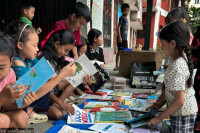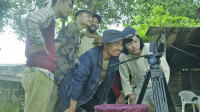Entertainment
BFA show at art council
Works by 17 graduating Fine Arts students are currently being exhibited in the halls of the Nepal Art Council, Babermahal.
Nhooja Tuladhar
The participating Studio Art students are Bikash Tamakhu, Kiran Maharjan, Kiran Rai, Kshitiz Gyawali, Matthias Plank, Niroj Marharjan, Prabal Bikram Shah, Prajwal Bhattarai, Prakash Ranjit, Pramod Thapa, Ramesh Kadayat, Saroj Lamichhane and Tsewang Lama, and the Graphic Communication students are Anish Bajracharya, Bhawana Tulachan, Shreejan Shrestha and Ubahang Limbu.
While Nepali galleries are generally occupied by images of landscapes (and portraits), ‘modern art’ or the now trending postmodernist works or ‘high art’, the BFA exhibition, which occupies the first two storeys of the gallery, works as a respite through its assorted arrangement of works that include ones that are conventional and others that are quite new to the Nepali gallery walls. This time around, the students have attempted at exploring mechanics (Rai’s and Bhattarai’s work) and journalism (Thapa’s and Shah’s work)—fields of study that are quite far from ‘art’.
Some works are based on collaborations—like that of Kadayat’s who joined hands and sculpting tools with a community of Kamaiya locals from Kailali, to create an array of miniature terracotta sculptures inspired by art styles of the area, and Kiran Maharjan’s digitally manipulated portraits, which represent the subjects’ interpretations of their respective ‘ideal deaths’.
The exhibition marks another point towards the shift in the Nepali artscape. While some in the collection follow trends, others, although not perfect, have proved to be more accessible to the audience, in the sense that they lack that heavy philosophical underpinning that only a handful can comprehend. They instead make up for it through their interactivity and fun-ness: things that could better aid people to appreciate art.
But what is most intriguing about the show are the works by the Graphic Communication students. The students have come up with high-quality products that they have designed and created themselves (remodeled in Bajracharya’s case), which proves the point that a good design, even in case of products, can come out of Nepal. A graphic design scene is almost non-existent in the country, but the outputs by these young designers show that it is only a matter of time. They haven’t strayed too far from Nepali-seeming elements but yet have managed to create products that have a sense of the original about them.
Calibre and capablitiy in case of art is subjective, and it would be wrong to expect the same output from two individuals from the same classroom. But with art displays like this one being organised every now and then and artists constantly growing through the efforts of schools like Lalitkala, Sirjana and KU(Art+design), there is all the more reason to be hopeful regarding the art scene in Nepal.
Today is the last day of the exhibition




 10.12°C Kathmandu
10.12°C Kathmandu










